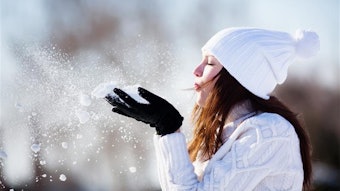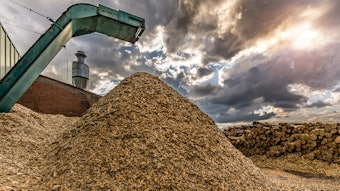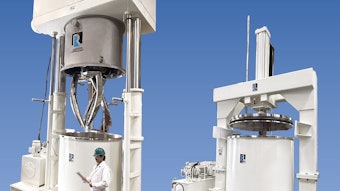Polyoxyethylene (20) sorbitan monolaurate (INCI: Polysorbate 20), is a ubiquitous nonionic surfactant employed in the formulation of countless cosmetic and personal care products. The use of polysorbate 20 is reported in 85%, i.e. 68 of 80, of the product categories listed in the Personal Care Product Council’s On-Line INFOBASE, indicating its versatility and utility in a variety of goods.1–2 It can function as a solubilizer, emulsifier, stabilizer, dispersing agent or a wetting agent, among other functions. Beyond personal care, polysorbate 20 has similar functions in the formulation and processing of pharmaceuticals, food and beverage products, agricultural chemicals and household and industrial cleaning products.
Polysorbate 20 is a complex mixture of laurate esters of sorbitol and sorbitol anhydrides (sorbitans), consisting predominantly of the monoester condensed with approximately 20 moles of ethylene oxide.1 The material generally conforms to the idealized structure shown in Figure 1—i.e., a four-arm, star-shaped oligomer of polyethylene glycol (PEG) grown from a sorbitan core with a laurate ester end-capping one of the PEG arms. This representative form of polysorbate 20 has an average molecular weight of 1,228 g/mol.
Chemistry and Manufacture
The key commodity feedstocks for polysorbate 20 are sorbitol, fatty acids with an average alkyl chain length of 12 carbon atoms, and ethylene oxide (EO).3–4 Sorbitol is a six-carbon sugar alcohol obtained from either the catalytic hydrogenation of glucose or the simultaneous hydrolysis and hydrogenation of starch, cotton cellulose or sucrose.5 The fatty acids consisting primarily of the C12 lauric acid are usually isolated by distillation of coconut or palm kernel fatty acids, which are obtained from saponification and hydrogenation of the respective oils. EO is a petrochemical intermediate produced by direct oxidation of ethylene gas using air or oxygen and a silver-based catalyst.
Polysorbate 20 may be synthesized by one of two possible routes: anhydrization and ethoxylation of sorbitol with 20 moles of EO to form sorbeth-20, followed by esterification with lauric acid;4, 6 or anhydrization of sorbitol and esterification with lauric acid to form sorbitan laurate (SL), followed by ethoxylation with 20 moles of EO.4, 7–9 In practice, the latter route, shown in Figure 2, is employed commercially and depending on the exact process, may utilize either base catalysis as shown or a combination of acid and base catalysis.
Polysorbate 20 is a complex material due to the number of possible compounds and structural isomers that may form during its synthesis. For example, in the first step, sorbitol is anhydridized using either an acidic or alkaline catalyst to form sorbitan, the cyclic ether of sorbitol obtained upon the loss of an equivalent of water.4–5 Figure 3 depicts the four isomers of sorbitan that may form during the anhydrization of sorbitol—in this case, acid-catalyzed. The major product is 1,4-sorbitan (typically ≥ 85%), yet three other isomers may also form in minor amounts; namely the 3,6-, 2,5- and 1,5-sorbitans.
Further anhydridization of the 1,4- and 3,6-sorbitans inevitably occurs during sorbitan synthesis and results in the formation of small amounts of isosorbide. If isosorbide is the desired product, it is obtained in high yield simply by driving the anhydridization of the 1,4- and 3,6-sorbitans with longer reaction times, higher temperatures, and/or by reacting under vacuum.
In the first step of polysorbate 20 synthesis, shown in Figure 2a, the base-catalyzed anhydrization of sorbitol to sorbitan is accompanied by simultaneous esterification with lauric acid to yield SL as the major product (1,4-sorbitan isomer, shown) producing water as a by-product. Esterification is possible at any of the four available hydroxyl (–OH) positions on the sorbitan; however, ester formation at the primary –OH groups is most favorable.10
Also formed in this reaction are minor amounts of the monolaurate ester of isosorbide, as well as diesters of sorbitan and isosorbide. Thus, SL is truly a complex composition of various species, not one distinct molecule. In addition to being a precursor for other nonionic surfactants, SL itself is useful as a low hydrophilic-lipophilic balance (HLB = 8.6) nonionic emulsifier.
SL is converted to polysorbate 20 by base-catalyzed oligomerization of EO initiated from the –OH groups of SL to add short PEG chains to the molecule, as illustrated in Figure 2b. Under these reaction conditions, extensive transesterification occurs and upon completion of the ethoxylation reaction, the laurate esters are positioned at the ends of the PEG chains.4, 10 A broad distribution of molecular configurations is possible but on average, the resulting product comprises a 20-mol ethoxylate of sorbitan bearing one laurate ester. Crude polysorbate 20 may be bleached and/or treated with activated carbon and filtered to lighten the color of the product. Additionally, steam- and/or vacuum-stripping techniques are employed to eliminate residual EO and reduce 1,4-dioxane by-product to levels of ≤ 5 ppm.11–12
Properties
Polysorbate 20 is a clear, yellow to amber colored, slightly viscous liquid nominally supplied as 100% active product; however, most grades of this hygroscopic material may contain up to 3% w/w water. The material is readily soluble in cold or hot water and has a cloud point in excess of 100°C at 2% w/w.13 Polysorbate 20 is nontoxic, nonirritating and remarkably mild to skin and eyes.11 Impurities in the material may include nonesterified ethoxylates, e.g. sorbeth-20; unreacted fatty acids, 1,4-dioxane and peroxides formed by auto-oxidation of the PEG chains.11
Peroxide formation in polysorbate 20 is of particular concern because it may degrade the purity, performance and appearance of the material and promote degradation of other compounds in a given formulation. High purity grades of polysorbate 20 minimize peroxide formation by eliminating the bleaching step during manufacturing and by transporting and storing the material in an inert atmosphere, e.g. under nitrogen.12
Applications
The many uses of polysorbate 20 in personal care, as previously mentioned, are well-known. Polysorbate 20 was a key material employed by Griffin in pioneering the development of the HLB system for emulsifier selection more than 60 years ago, a system still used today.4, 7, 14 With an HLB value of 16.7, polysorbate 20 is a potent micro-emulsifier for the solubilization of water-insoluble compounds, e.g. active ingredients, fragrance oils, etc., and in combination with SL, polysorbate 20 is a highly effective o/w emulsifier.
Like other high-HLB ethoxylated nonionic surfactants, polysorbate 20 may be used to decrease the irritation potential of harsh detersive surfactants; in fact, it was employed in the development of the first baby shampoo products.13 The compound is also used to decrease the viscosity of surfactant solutions, presumably due to its ability to disrupt the formation of entangled worm-like micelles.
Formulation Guidelines
Polysorbate 20 is known to deactivate preservatives (parabens) and antimicrobials due to its propensity to sequester these compounds into its nonionic micelles.11, 15 Although parabens are the most notable example, polysorbate 20 may also deactivate organic acids such as benzoic acid and sorbic acid as well as benzyl alcohol.
In addition, it may deactivate antimicrobials such as the cationic surfactants benzalkonium chloride and cetylpyridinium chloride. Therefore, polysorbate 20 must be used judiciously and the activity of preservatives and antimicrobials should always be verified via the appropriate efficacy tests when used with polysorbate 20.
References
1. Polysorbate 20, Monograph ID 2451, in the International Cosmetic Ingredient Dictionary and Handbook, 13th edn, Personal Care Products Council, Washington DC (2010)
2. Ingredient info lists, Reported Product Categories, Personal Care Products Council On-Line INFOBASE, https://online.personalcarecouncil.org/jsp/Home.jsp (Accessed Mar 9, 2011)
3. BA Kerwin, Polysorbates 20 and 80 used in the formulation of protein biotherapeutics: Structure and degradation pathways, J Pharm Sci 97 8 2924–2935 (2008)
4. FR Benson, Polyol Surfactants, ch 9 in Nonionic Surfactants, Surfactant Science Series vol. 1, MJ Schick, ed, Marcel Dekker, New York (1966) pp 247–299
5. ME Lawson, Sugar Alcohols, in Kirk-Othmer Encyclopedia of Chemical Technology, John Wiley and Sons (online) (Dec 4, 2000) pp 1–24
6. US Pat 2450079, Waxy polyol ether-esters, KR Brown, assigned to Atlas Powder Company (Sep 28, 1948)
7. US Pat 2374931, Wax composition, WC Griffin, assigned to Atlas Powder Company (May 1, 1945)
8. US Pat 2380166, Emulsions, WC Griffin, assigned to Atlas Powder Company (Jul 10, 1945)
9. US Pat 4297290, Process for preparing sorbitan esters, GJ Stockburger, assigned to ICI Americas Inc. (Oct 27, 1981)
10. JD Brandner, The composition of NF-defined emulsifiers: Sorbitan monolaurate, monopalmitate, monostearate, monooleate, polysorbate 20, polysorbate 40, polysorbate 60 and polysorbate 80, Drug Dev Ind Pharm 24 11 1049–1054 (1998)
11. RL Elder, ed, Final Report on the Safety Assessment of Polysorbates 20, 21, 40, 60, 61, 65, 80, 81 and 85, J Am Coll Toxicol 3(5) 1–82 (1984)
12. SPANS and TWEENS, Croda Product Bulletin PN-15R-9, Croda Inc., Edison, NJ (Jul 17, 2000)
13. US Pat 3055836, Detergent composition, JN Masci and NA Poirier, assigned to Johnson & Johnson (Sep 25, 1962)
14. RC Pasquali, N Sacco and C Bregni, The studies on hydrophilic-lipophilic balance (HLB): Sixty years after William C. Griffin’s pioneer work (1949–2009), Lat Am J Pharm 28 2 313–317 (2009)
15. DL Wedderburn, Preservation of toilet preparations containing nonionics, J Soc Cosmetic Chem 9 4 210–228 (1958)










